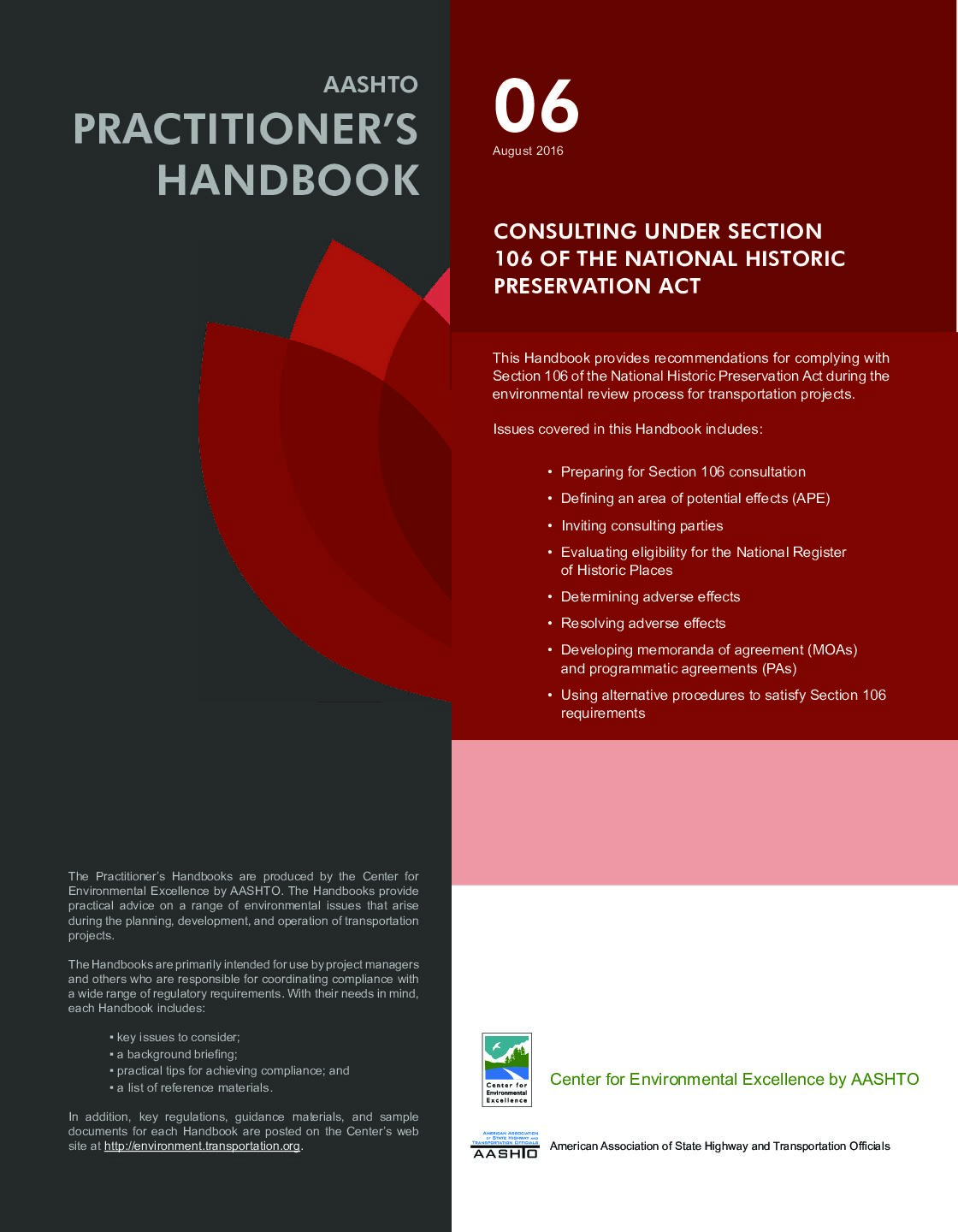Consulting Under Section 106 of the National Historic Preservation Act
Home » Resources & Research » Practitioner’s Handbooks » Consulting Under Section 106 of the National Historic Preservation Act

Consulting Under Section 106 of the National Historic Preservation Act
The Handbook clarifies and provides information to project managers on the successful integration of Section 106 and the National Environmental Policy Act (NEPA) with a specific focus on Section 106 as it applies to transportation projects for which the project applicant is a state department of transportation (DOT). The Handbook is not a beginner introduction to the Section 106 process, nor is it an exhaustive technical guide for Section 106 practitioners.
Practical tips include preparing for Section 106 consultation, defining an area of potential effects (APE), inviting consulting parties and public involvement; evaluating eligibility for the National Register of Historic Places;, determining and resolving adverse effects, developing memoranda of agreement (MOAs) and programmatic agreements (PAs), and using alternative procedures to satisfy Section 106 requirements.
View the online Programmatic Agreement Library (PAL) for Section 106
Handbook Resources
General Reference
ACHP Website
http://www.achp.gov
The Secretary of Interior’s Standards and Guidelines
http://www.cr.nps.gov/local-law/arch_stnds_0.htm
Section 106 Consultation Steps
ACHP and CEQ, “NEPA and NHPA – A Handbook for Integrating NEPA and Section 106” (March 2013)
ACHP, “NEPA and Section 106 Process Flowcharts”
http://www.achp.gov/docs/NEPA%20and%20Section%20106%20Coordination%20P
rocess%20Flow%20Charts.pdf
Identification and Eligibility Evaluation
ACHP, “Meeting the ‘Reasonable and Good Faith Identification’ Standard in Section 106 Review”
http://www.achp.gov/docs/reasonable_good_faith_identification.pdf
National Park Service bulletins for applying the National Register eligibility criteria
http://www.cr.nps.gov/nr/publications/bulletins.htm
Section 106 Agreement Documents
ACHP, “Guidance on Agreement Documents”
http://www.achp.gov/agreementdocguidance.html
ACHP, Applicant Toolkit and Checklist
http://www.achp.gov/apptoolkit.html
ACHP, “Prototype Programmatic Agreement Guidance” (Feb. 3, 2012)
http://www.achp.gov/docs/guidance_prototype_agreements.pdf
Tribal Consultation
National Association of Tribal Historic Preservation Officers (NATHPO) website
http://www.nathpo.org
ACHP, “Consultation with Indian Tribes in the Section 106 Review Process: A Handbook” (Nov. 2008)
http://www.achp.gov/regs-tribes2008.pdf
ACHP, “Native American Traditional Cultural Landscapes and the Section 106 Review Process: Questions and Answers”
http://www.achp.gov/docs/landscapes%20q%20&%20a%207-11-12.pdf
Interstate Highway System
ACHP’s Section 106 exemption for the Interstate System
http://www.achp.gov/final_interstate_exemption_notice.pdf
FHWA’s list of Interstate System elements that are excluded from the exemption for the Interstate System
http://www.environment.fhwa.dot.gov/histpres/highways_list.asp
Mid-Century Bridges
ACHP, “Program Comment for Actions Affecting Post-1945 Concrete and Steel Bridges” (Nov. 16, 2012)
http://www.achp.gov/progalt/Post-1945%20Bridge%20Program%20Comment.pdf
National Historic Landmarks
ACHP, “Section 106 Consultation Involving National Historic Landmarks”
http://www.achp.gov/regs-nhl.html
Emergency Response
ACHP, “Role of Section 106 in Disaster Response – Frequently Asked Questions”
http://www.achp.gov/sec106_disaster-responseFAQ.html
FAST Act Guidance
FHWA guidance regarding Section 106 and Section 4(f) provisions in the FAST Act
https://www.fhwa.dot.gov/fastact/guidance.cfm